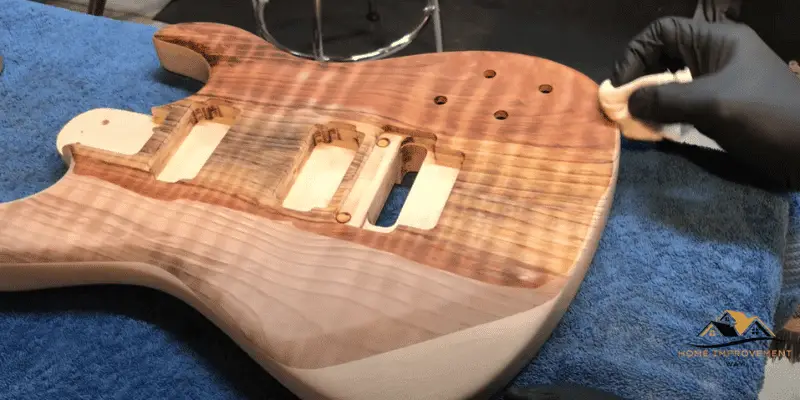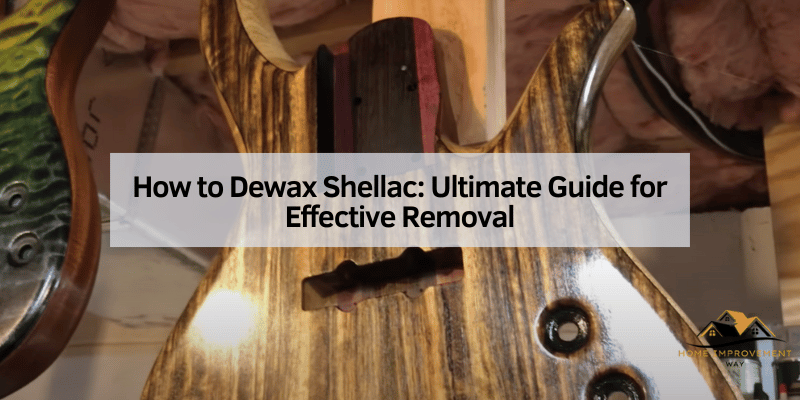To dewax shellac, dissolve it in denatured alcohol, then filter out the impurities. Dewaxing shellac is an essential process to remove the wax content from the shellac resin.
This is necessary to achieve a pure and high-quality shellac finish for woodworking, furniture restoration, or other applications. By removing the wax, you can ensure better adhesion, clarity, and durability of the shellac. Understanding the proper methods and techniques for dewaxing shellac is crucial for achieving professional results in your projects.
We will explore the step-by-step process of dewaxing shellac, along with tips and important considerations to help you achieve a flawless finish. Whether you are a beginner or an experienced craftsman, mastering the dewaxing process will significantly elevate the quality of your shellac finishes.
Understanding The Shellac Wax Buildup
`Understanding the Shellac Wax Buildup can be crucial for ensuring the successful removal of wax from shellac finishes. Shellac, a natural resin secreted by the lac bug, often contains wax, which can lead to buildup over time. Prior to delving into the methods of dewaxing shellac, it is essential to comprehend the characteristics of shellac wax and the potential impact of its buildup on surfaces.`
`characteristics Of Shellac Wax`
`Shellac wax comprises a complex mixture of esters, fatty acids, and hydrocarbons. It is responsible for providing the distinctive sheen and protective properties to shellac finishes. The wax content in shellac acts as a natural water repellent and enhances the durability of the finish.`
`impact Of Wax Buildup On Surfaces`
`Excessive wax buildup can lead to a dull and hazy appearance of shellac finishes, compromising their visual appeal. Moreover, it may interfere with the adhesion of subsequent coatings or repairs, resulting in poor surface performance. The accumulation of wax can also diminish the ability of shellac to bond effectively, leading to potential adhesion issues.`

Assessing Tools And Materials Needed
Essential Tools For Dewaxing
Before embarking on the dewaxing process for shellac, it’s crucial to gather the essential tools. Having the right equipment on hand will ensure a smooth and efficient dewaxing procedure. Here are the key tools required:
- Denatured alcohol
- Clean and lint-free cloths
- Soft-bristled brush or vacuum
- Plastic putty knife or scraper
- Mineral spirits
- Steel wool or abrasive pad
Required Safety Equipment
Prioritizing safety is paramount when working with chemicals and solvents. In order to undertake the dewaxing process safely, the following safety equipment is essential:
- Nitrile or latex gloves
- Safety goggles or protective eyewear
- Respirator mask with organic vapor cartridges
- Well-ventilated workspace or use of a respirator for fume protection
Step-by-step Process For Dewaxing Shellac
Dewaxing shellac can be done in six simple steps. Start by dissolving the shellac in alcohol, then let it sit to allow the wax to settle at the bottom. Carefully pour the clear liquid into a new container, leaving the wax behind.
Repeat this process to make sure all the wax is removed.
Removing Old Shellac Wax Layers
Before beginning the dewaxing process, ensure that the old shellac wax layers have been thoroughly removed from the surface.
- Start by sanding the surface using fine-grit sandpaper to eliminate any old wax layers.
- Use a soft cloth to wipe away the sanding residue and ensure the surface is clean and free from any dust or debris.
Applying Effective Dewaxing Agents
Once the old shellac wax layers have been removed, it’s crucial to use effective dewaxing agents to ensure a successful dewaxing process.
- Choose an appropriate dewaxing agent suitable for the type of shellac being used and apply it to the surface using a clean cloth or brush.
- Allow the dewaxing agent to sit on the surface for the specified time according to the product instructions.
- Using a clean cloth, wipe away the dewaxing agent along with the dissolved wax and residue. Ensure the surface is clean and free from any remaining wax.
Techniques For Thorough Shellac Removal
When it comes to removing shellac, it’s essential to use the right techniques to ensure thorough removal without damaging the underlying surface. Whether you’re dealing with stubborn wax buildup or delicate surfaces that require a gentle approach, there are various methods to achieve effective shellac removal. Below, we’ll explore mechanical and chemical techniques tailored to specific removal needs, providing a comprehensive guide for achieving a clean and shellac-free surface.
Mechanical Methods For Stubborn Wax
Stubborn wax buildup can be challenging to remove, especially in intricate or hard-to-reach areas. Mechanical methods offer a hands-on approach to effectively eliminate stubborn shellac deposits. Utilizing tools such as scrapers, steel wool, and abrasives allows for targeted removal of wax buildup without causing damage to the underlying surface.
Chemical Alternatives For Delicate Surfaces
When dealing with delicate surfaces that require a gentler approach, chemical alternatives provide an effective solution for shellac removal. Utilizing solvents and specialized cleaning solutions can break down shellac and wax without causing damage or discoloration to sensitive materials such as antique furniture or intricate woodwork.
Final Touches And Maintenance
Polishing And Waxing The Surface
After dewaxing shellac, it’s essential to apply a layer of polish and wax to achieve a beautiful, glossy finish. Start by gently polishing the surface with a soft cloth or a #0000 steel wool pad to even out any imperfections and restore its luster. Apply the polish in small circular motions, working until the entire surface shines. Once the surface is polished, proceed to apply a thin layer of wax using a clean cloth, following the direction of the wood grain. This will add an extra layer of protection and enhance the sheen of the shellac.
Preventing Future Wax Buildup
To prevent future wax buildup, it’s crucial to establish a regular maintenance routine for your shellac-finished surfaces. Implement the following practices to keep your shellac looking flawless:
- Dust regularly: Use a soft, lint-free cloth to dust the surface of your shellac-finished furniture or woodwork. This will prevent dirt and debris from accumulating and mixing with wax.
- Use a pH-neutral cleaner: When cleaning shellac surfaces, opt for a pH-neutral cleaner to avoid damaging the finish. Mix a small amount of cleaner with water and gently wipe the surface with a soft cloth.
- Avoid excessive moisture: Keep shellac-finished items away from excessive moisture, as prolonged exposure can cause the wax to soften and accumulate on the surface.
- Periodic re-waxing: Over time, the wax protective layer may wear off. To maintain the luster and protection, consider reapplying a thin layer of wax every 6-12 months, depending on use and exposure.
Frequently Asked Questions On How To Dewax Shellac
How To Dewax Shellac Before Refinishing Furniture?
Dewaxing shellac before refinishing furniture involves using denatured alcohol to remove wax and impurities from the surface. Apply the alcohol using a clean cloth and use gentle, circular motions. Be sure to work in a well-ventilated area and wear protective gloves.
What Are The Benefits Of Dewaxing Shellac?
Dewaxing shellac offers the benefit of ensuring a clean and smooth surface for refinishing furniture. Removing wax and impurities allows for better adhesion of the new finish, resulting in a professional-looking and long-lasting outcome.
Can I Use Other Methods To Dewax Shellac?
Yes, you can also use mineral spirits or a commercial wax remover to dewax shellac. However, denatured alcohol is a commonly preferred and effective method due to its ability to dissolve wax and impurities without leaving residue. Always follow safety precautions when using these solvents.
Conclusion
Dewaxing shellac is a simple process that requires minimal effort but provides significant benefits. By following the steps outlined in this guide, you can easily remove wax from shellac and enhance the quality of your woodworking projects. With the right techniques and tools, you can achieve a flawless finish and bring out the natural beauty of the wood.
Start dewaxing your shellac today and take your woodworking to the next level.


